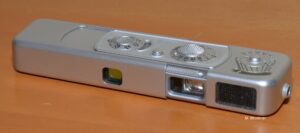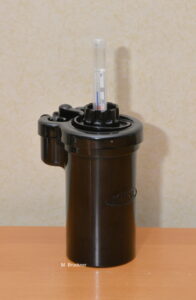Minox
At some point you will automatically come to Minox as a collector. Everyone knows them, many have had one and lost it somewhere, but all have liked, if not loved, them. The Minox has remained something special to this day.

The „agent camera“ was developed in Riga, Latvia, by Walter Zapp, who wanted a small, light camera that could be hidden in one hand. He really succeeded in this project. The shutter is cocked with one movement, the time is set with a turn and the shutter can be released. The aperture can be neglected, because the 15mm Complan lens works with a fixed aperture of 3.5. Due to the special film format of 8 X 11 mm, there is still an angle of view corresponding to a 50mm lens in 35mm. A specialty was the automatic parallax compensation of the viewfinder. Depending on the distance setting, the viewfinder rotates towards the lens. The installation of two color filters that could be pushed in front of the lens was also advantageous. My little Minox is a fully mechanical Minox B with a built-in and coupled exposure meter. Year of construction approx. 1960.

From 1969, modern semiconductor technology also found its way into the fully mechanical miniature cameras. With the Minox C, automatic exposure was implemented using a CdS exposure meter and transistor control. The mechanically adjustable times are only required for flashing and for individual image composition. A freewheel for the film transport, which prevents unintentional switching, could also be built into the Minox C for the first time. Most of the accessories from the previous models, such as the tripod or clip-on flash units, can also be used on this small camera.

The specially designed developer can is indispensable when developing the exposed Minox films.
The film can be wound into the can in full daylight. Pour in a small amount of developer liquid (53cc), move the supplied thermometer up and down from time to time to ensure good circulation and work according to the developer’s timetable.

Then soak and fix. Only then do you open the can, remove the film and let it dry. This works splendidly with the black and white films that are still available and it is always a pleasure to look at the finished negatives in their impressive resolution for the small format.
The punch, specially developed for slides and equipped with a magnifying glass, is ideal for looking at the developed negatives for the first time.
It can also be used to fit slides into the 3 x 3 centimeter frames.

From 1974, Minox expanded its product range to include 35mm film, with the requirement not to build the cameras larger than absolutely necessary. The first model, the Minox 35 EL, was the smallest 35mm viewfinder camera and undercut the Rollei 35 in size and weight. However, the 4-lens Minotar (Tessar type) could not keep up with the Rollei lenses in terms of imaging performance. But the customers didn’t mind, the light and modern-looking Minox cameras were a great sales success. The adjacent Minox GT 35 was sold from 1981. The light Makrolon housing, the simple operation with exposure indicator in the viewfinder and the Minotar lens, which is perfectly adequate for most snapshots, made this camera one of the best-selling cameras in the Minox 35 range. For the first time, an electronic self-timer was offered, the DIN/ISO setting of the inserted film could be continuously adjusted. Two system flash units that are adapted to the roof-shaped camera housing complete the camera equipment for the vest pocket.

In 1985, the Minox 35 ML, the new top model, was presented in a modified case. For the first time with Minox, there was a program automatic that selects the time and aperture automatically. Furthermore, the already known aperture priority (with aperture preselection). With the sharply defined 35mm Minotar 4-lens lens, self-timer, backlight button and the display of the most important functions in the viewfinder via LEDs (automatically adjusted to the brightness), this cigarette-box-sized camera leaves nothing to be desired. With the powerful MT 35 automatic flash, the Minox is also ideally equipped for dark subjects.
As a quick snapshot with good optical properties, this quality product should not be missing in any jacket pocket.

Even the Minox company could not avoid looking for new purchase incentives in the late 1980s.
A metal Minox 35 ML was considered. The trick to this device should be a metallization of the existing Makrolon housing in order not to increase the weight unnecessarily.
According to employee statements, about 5 prototypes were made, as can be seen here. Unfortunately, the camera body now turned out to be electrically conductive. Due to the limited space available, it was no longer possible to reliably insulate the electronic components.
The project has been discontinued.
Go to Cassette Cameras or Home
